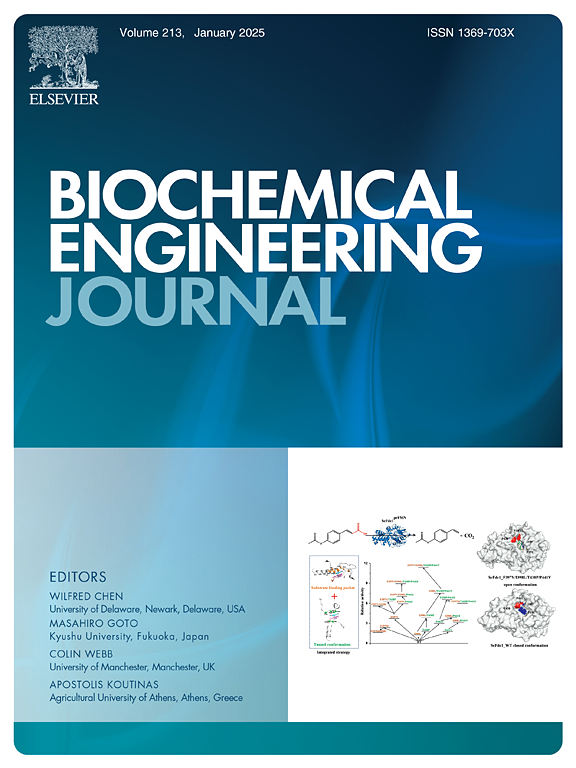Simultaneous nitrogen and sulfur removal in a constructed rapid infiltration system with red mud/manganese-modified coke: Performance and mechanisms
IF 3.7
3区 生物学
Q2 BIOTECHNOLOGY & APPLIED MICROBIOLOGY
引用次数: 0
Abstract
Water pollution from nitrogen/sulfur compounds threatens aquatic ecosystems and human health. In this study, the removal of chemical oxygen demand (COD), sulfate, and NH4+ -N from wastewater was compared between the constructed rapid infiltration systems (CRIS) using coke (group A), modified red mud and coke (group B), and manganese-modified coke (group C). When the concentration of sulfate was increased from 50 to 100 mg/L, the average removal rates of sulfate in groups A, B, and C were 51.8 ± 9.90 %, 53.4 ± 5.99 %, and 64.9 ± 6.50 %, and the average removal rates of NH4+-N were 41.5 ± 5.69 %, 60.1 ± 5.15 %, and 50.5 ± 4.47 %. The manganese-modified coke could strengthen the treatment efficiency of the CRIS for sulfate. Microbial analyses revealed that Proteobacteria (>50 % abundance) dominated all systems, and the abundance of Brucella increased from 0.83 % to 3.53 % in group C. Furthermore, the metabolic mechanisms indicated that group C enhanced sulfur metabolism (53.3 % increase in sulfite reduction) and nitrogen cycling (elevated glycolysis/ammonia oxidation). In addition, the electron transfer efficiency in the modified red mud group was improved. These findings highlight that through manganese modification, the CRIS could coordinate sulfur and nitrogen metabolic pathways through microbial regulation, thereby providing a feasible solution for synergistic control of multiple pollutants in complex wastewater.
赤泥/锰改性焦炭快速渗滤系统同时脱氮除硫的性能及机理
氮/硫化合物造成的水污染威胁着水生生态系统和人类健康。在本研究中,比较了使用焦炭(A组)、改性赤泥和焦炭(B组)和锰改性焦炭(C组)构建的快速渗透系统(CRIS)对废水中化学需氧量(COD)、硫酸盐和NH4+ -N的去除效果。硫酸的浓度增加时从50到100 mg / L,硫酸的平均去除率在组,B和C 51.8 ±9.90 %,53.4 ± % 5.99和64.9 ±6.50 %,和NH4 + - n的去除率平均41.5 ±5.69 %,60.1 ± % 5.15和50.5 ±4.47 %。锰改性焦可以提高CRIS对硫酸盐的处理效率。微生物分析显示,所有系统中Proteobacteria (>;50 %丰度)占主导地位,其中布鲁氏菌丰度在C组从0.83 %增加到3.53 %。此外,代谢机制表明,C组增强了硫代谢(亚硫酸盐还原增加53.3% %)和氮循环(糖酵解/氨氧化升高)。此外,改性赤泥组的电子传递效率也有所提高。这些发现表明,通过锰改性,CRIS可以通过微生物调控协调硫氮代谢途径,从而为复杂废水中多种污染物的协同控制提供了可行的解决方案。
本文章由计算机程序翻译,如有差异,请以英文原文为准。
求助全文
约1分钟内获得全文
求助全文
来源期刊

Biochemical Engineering Journal
工程技术-工程:化工
CiteScore
7.10
自引率
5.10%
发文量
380
审稿时长
34 days
期刊介绍:
The Biochemical Engineering Journal aims to promote progress in the crucial chemical engineering aspects of the development of biological processes associated with everything from raw materials preparation to product recovery relevant to industries as diverse as medical/healthcare, industrial biotechnology, and environmental biotechnology.
The Journal welcomes full length original research papers, short communications, and review papers* in the following research fields:
Biocatalysis (enzyme or microbial) and biotransformations, including immobilized biocatalyst preparation and kinetics
Biosensors and Biodevices including biofabrication and novel fuel cell development
Bioseparations including scale-up and protein refolding/renaturation
Environmental Bioengineering including bioconversion, bioremediation, and microbial fuel cells
Bioreactor Systems including characterization, optimization and scale-up
Bioresources and Biorefinery Engineering including biomass conversion, biofuels, bioenergy, and optimization
Industrial Biotechnology including specialty chemicals, platform chemicals and neutraceuticals
Biomaterials and Tissue Engineering including bioartificial organs, cell encapsulation, and controlled release
Cell Culture Engineering (plant, animal or insect cells) including viral vectors, monoclonal antibodies, recombinant proteins, vaccines, and secondary metabolites
Cell Therapies and Stem Cells including pluripotent, mesenchymal and hematopoietic stem cells; immunotherapies; tissue-specific differentiation; and cryopreservation
Metabolic Engineering, Systems and Synthetic Biology including OMICS, bioinformatics, in silico biology, and metabolic flux analysis
Protein Engineering including enzyme engineering and directed evolution.
 求助内容:
求助内容: 应助结果提醒方式:
应助结果提醒方式:


